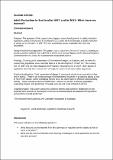Files in this item
Adult protection in Scotland in 1857 and in 2015 : what have we learned?
Item metadata
| dc.contributor.author | Campbell, Martin | |
| dc.date.accessioned | 2016-02-26T12:10:04Z | |
| dc.date.available | 2016-02-26T12:10:04Z | |
| dc.date.issued | 2016-04-11 | |
| dc.identifier | 241041222 | |
| dc.identifier | 76e2e53a-0a14-41d0-b0c7-0100faae0641 | |
| dc.identifier | 84962714009 | |
| dc.identifier | 000379652000004 | |
| dc.identifier.citation | Campbell , M 2016 , ' Adult protection in Scotland in 1857 and in 2015 : what have we learned? ' , The Journal of Adult Protection , vol. 18 , no. 2 , pp. 96-108 . https://doi.org/10.1108/JAP-09-2015-0025 | en |
| dc.identifier.issn | 1466-8203 | |
| dc.identifier.uri | https://hdl.handle.net/10023/8317 | |
| dc.description | The research was funded by the Carnegie Foundation in Scotland. | en |
| dc.description.abstract | Purpose: The purpose of this paper is to compare recent developments in adult protection legislation, policy and practice in Scotland in 2015 with the first attempts at adult protection of adults at risk of harm, in 1857-62, with a particular focus on people with learning disabilities. Design/methodology/approach: The paper uses comparative historical research, drawing on primary archive material from 1857-62 in the form of Annual Reports of the General Board of Commissioners in Lunacy for Scotland and associated papers. Findings: Growing public awareness of the extent of neglect and abuse, and the need for overarching legislation were common factors in the development of both the “The Lunacy Act” of 1857 and the Adult Support and Protection (Scotland) Act of 2007. Both pieces of legislation also had the common aim of “asylum”, and shared some other objectives. Practical implications: Total prevention of abuse of vulnerable adults is an aspiration in law and in policy. There is an evidence base of effectiveness however in protecting adults at risk of harm from abuse. Some ecological factors recur as challenges to effective safeguarding activity. These include problems of definition, uncovering abuse, enforcing legislation, evaluating impact, and protection of people who are not a risk of harm to others. Originality/value: This paper compares common themes and common challenges in two separate time periods to investigate what can be learned about development of legislation and practice in adult protection. | |
| dc.format.extent | 13 | |
| dc.format.extent | 554870 | |
| dc.language.iso | eng | |
| dc.relation.ispartof | The Journal of Adult Protection | en |
| dc.subject | Adult protection | en |
| dc.subject | Legislation | en |
| dc.subject | Learning/intellectual disabilities | en |
| dc.subject | Historical research | en |
| dc.subject | Safeguarding | en |
| dc.subject | Mental health | en |
| dc.subject | HV Social pathology. Social and public welfare | en |
| dc.subject | Psychology(all) | en |
| dc.subject | Health Professions(all) | en |
| dc.subject | T-NDAS | en |
| dc.subject | BDC | en |
| dc.subject | SDG 3 - Good Health and Well-being | en |
| dc.subject.lcc | HV | en |
| dc.title | Adult protection in Scotland in 1857 and in 2015 : what have we learned? | en |
| dc.type | Journal article | en |
| dc.contributor.sponsor | Carnegie Trust | en |
| dc.contributor.institution | University of St Andrews. School of Psychology and Neuroscience | en |
| dc.contributor.institution | University of St Andrews. Office of the Principal | en |
| dc.identifier.doi | 10.1108/JAP-09-2015-0025 | |
| dc.description.status | Peer reviewed | en |
| dc.identifier.grantnumber | 31766 | en |
This item appears in the following Collection(s)
Items in the St Andrews Research Repository are protected by copyright, with all rights reserved, unless otherwise indicated.

